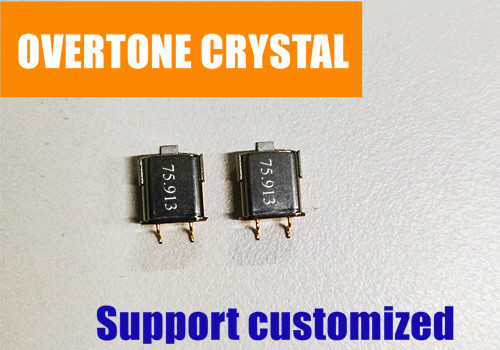What are fundamental frequency crystals and overtone crystals?
What are fundamental frequency crystals and overtone crystals?

Fundamental frequency crystals:
Fundamental frequency crystals are crystals that oscillate at their base frequency. For example, a crystal with a base frequency of 20MHz oscillates at 20MHz. As a general rule, crystals with base frequencies below 40MHz are considered fundamental frequency crystals.
Overtone crystals:
Overtone crystals are crystals that oscillate at frequencies that are multiples of their fundamental frequency. For example, a crystal with a fundamental frequency of 20MHz can be used to obtain an overtone crystal with a frequency of 100MHz by using five overtones. Generally, crystals with base frequencies above 40MHz are overtone crystals. The mechanical harmonics of the crystal vibration produce overtone frequencies, such as 3 overtones, 5 overtones, 7 overtones, and 9 overtones. For example, 3 overtones range from 60-120MHz, 7 overtones range from 280-400MHz, and 9 overtones range from 450-600MHz.
Why do we need to differentiate between fundamental frequency and overtone crystals?
Crystal oscillators are made of quartz or ceramic with internal wafer combinations. The thickness of the wafer determines the crystal's frequency, and as a general rule, a higher frequency crystal requires a thinner wafer. For example, a 100 MHz quartz crystal needs a wafer thickness of 16.7 µm, resulting in a fragile finished product with high losses. Therefore, high-frequency crystals are generally more expensive.
Overtone crystals require the use of inductors and capacitors to vibrate at the overtone frequency, otherwise, they will only vibrate at the fundamental frequency. Fundamental frequency crystals only require appropriate capacitors to function.
When a crystal operates in the fundamental mode, its impedance is at its lowest value, making it easier to start. If the crystal operates in triple overtone mode, a tuning circuit must be used to reduce the degree of frequency feedback generated by the crystal in fundamental mode to at least one-third of the output frequency in triple overtone mode. This is necessary to minimize the effect on the output frequency in triple overtone mode. Therefore, if the crystal output frequency is only one-third of the target frequency, it's important to check whether an amplification circuit is being used. If the circuit environment is confirmed to be suitable for a fundamental frequency crystal rather than a triple overtone crystal, it's crucial to confirm that the electrical parameters of the fundamental frequency crystal are accurate.
If the crystal output frequency is three times the target frequency, it's unlikely that this problem will occur. However, it's still important to check that the frequency feedback in the three overtone modes does not exceed the fundamental frequency feedback due to the amplifier circuit. This problem can occur if the chip already has a built-in amplifier circuit that is not designed for a three-times overtone crystal. The solution is to select a three-times overtone crystal.
It's important to note that if the amplification circuit for a three-times overtone crystal is not designed properly, it can also cause the oscillation circuit to malfunction or not work at all, such as when the amplification circuit is for five overtones.
Xtalong electronics support customizations of overtone crystal , here's Success stories
